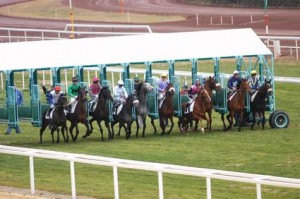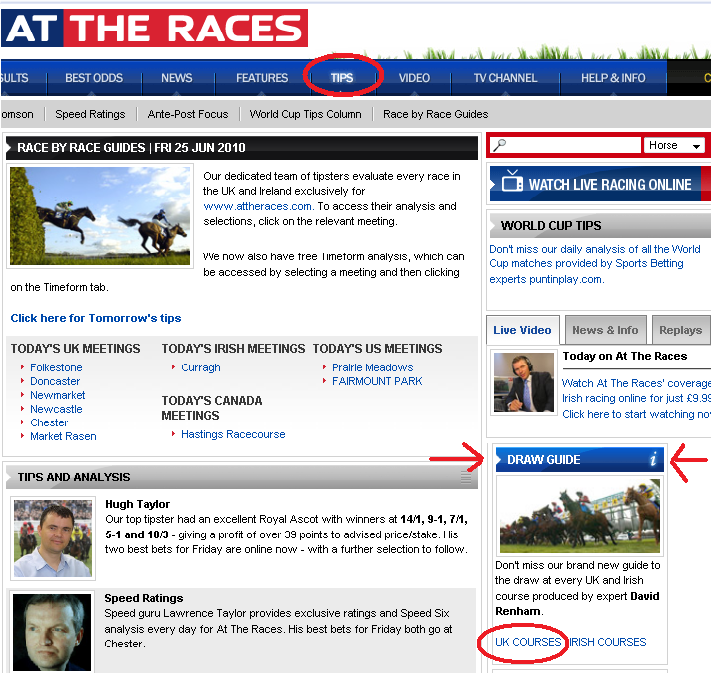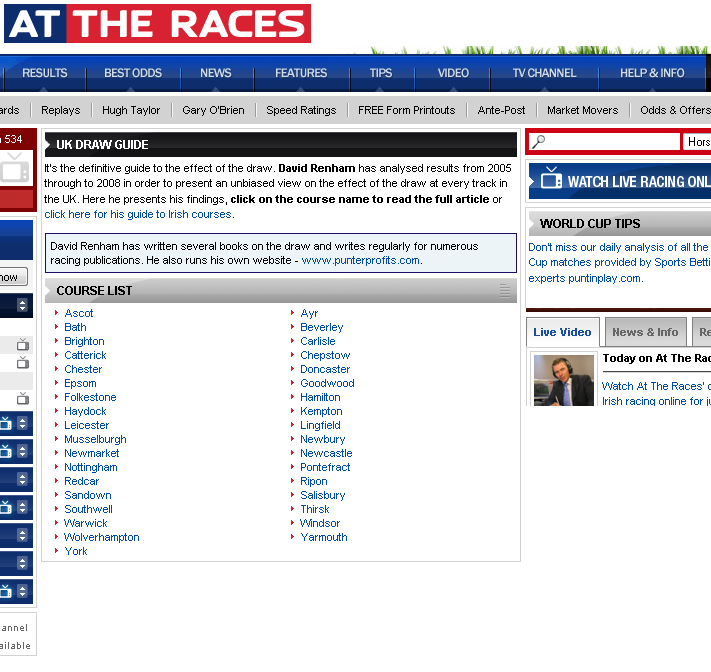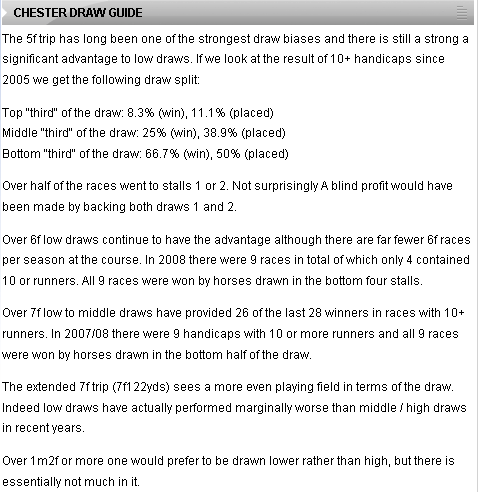Draw Bias Guides
 The results of Flat races are often influenced by the draw, especially over shorter distances. On some courses a really bad draw can be impossible to overcome, whilst on others there are starting positions which can give a horse a big advantage, especially if those animals have conditions to suit.
The results of Flat races are often influenced by the draw, especially over shorter distances. On some courses a really bad draw can be impossible to overcome, whilst on others there are starting positions which can give a horse a big advantage, especially if those animals have conditions to suit.
The main problem associated with draw biases is they frequently change, so any completely rigid set of rules with regards to a particular bias often becomes irrelevant when conditions change. Whether you are backing or laying within the flat turf season, it really is worth paying attention to draw biases. The following factors will help you assess and combine racing fundamentals with the effects of the draw.
1: Shape of the course.
British races courses come in all shapes and sizes. Some have long sweeping bends, whilst others are totally straight, and there are plenty of different configurations in between. This is exactly why biases are different at each course; no two are exactly the same.
This partly explains why certain horses perform well at a particular course and fail miserably at another, even when they may first appear to have conditions to suit. Basically horses like human athletes have their own style of running. Most courses are either suited to those animals that like to race prominently, or those that that like to be held up. The old cliché horses for courses is therefore true to an extent.
2: Inside Rail
When bends are left handed the lowest drawn stalls are 1 and 2; closest to the running rail. It is often documented that low stall numbers at certain courses have some kind of advantage. It is well worth opposing those that are badly drawn if you can get a lay on at a value price that is.
3: How many runners
The size of the field can have a significant effect on how a draw bias will play out. In small field races for example – with 7 runners or less all the horses will be running on the same part of the course, usually near to, or on the inside rail. Conversely in large fields of 20 runners or more the field is likely to split into two almost separate races. In effect stall 1 and stall 20 will be on complete opposite sides of the course.
4: Grounds for concern
The going can affect how a horse performs even when it has a good stalls position. This is more exaggerated on soft ground because it places more of a premium on stamina. Basically if a horse is unsuited to the going and its race history clearly shows this then a stalls position deemed to be an advantage is likely to become irrelevant.
5: Distance
There is plenty of evidence that short races – 5-6-7f can be more influenced by the draw. If a horse misses the break, or has a bad stalls position it has less time to regain the lost ground and get back into contention. Furthermore the animal is likely to expend too much vital energy trying to do so; thus leaving it lacking the necessary speed to get competitive at the business end of a race.
6. The horses running style.
Horse that like to front run or race prominently can gain a big advantage from a good stalls position; conversely the same stall position will probably not have the desired effect on a hold up horse or one that likes to race behind the leaders for most of the trip.
Now we have established some of the less considered factors that play a part in how a flat races can potentially pan out, in relationship to the Draw. Lets look at some resouces to actualy help you take advantage of track biases.
Resources
Here you`ll find links to some very useful draw guides for all the UK`s race courses. Pay special attention to the At The Races DRAW GUIDE, which is compiled by one the UK`s most respected betting authorities – David Renham. In this definitive guide to the effect of the draw. Dave has analysed results from 2005 through to 2008 in order to present an unbiased view on the effect of the draw at every track in the UK. Here he presents his findings. This invaluable guide will gve you a serious betting edge when it comes to assessing a horses chances in flat racing. Especially in sprints on courses with strong draw biases.
Follow the steps below to access this fantastic betting tool.
Step 1:
Visit At The Races website > click on the TIPS TAB
Step 2:
Click on UK COURSES
Step 3:
Once on the Draw Guide page. Simply click on any of the UK race courses to view detailed information about that courses draw Biases. See Screenshot 3 below for an example.
Screenshot 3:
PLEASE NOTE:
The Draw Bias work Dave Renham did for ATR was a one off point in time piece and the Draw is ever changing. An area best kept up to date on etc.
Dave’s trend service includes amongst it’s daily out put – details of strong positive and negative draw biases when they occur. So compared to ATR it is…
1 – More up to Date
2 – More detailed
3 – Arrives in your inbox clearly highlighted.
To get more information and this service delivered to your inbox>>>Click Here
Pro Tip
To get more Expert, advice, tips and FREE downloads. Simply visit our Free Downloads page RIGHT NOW!










